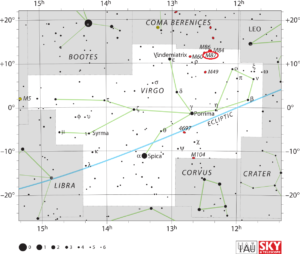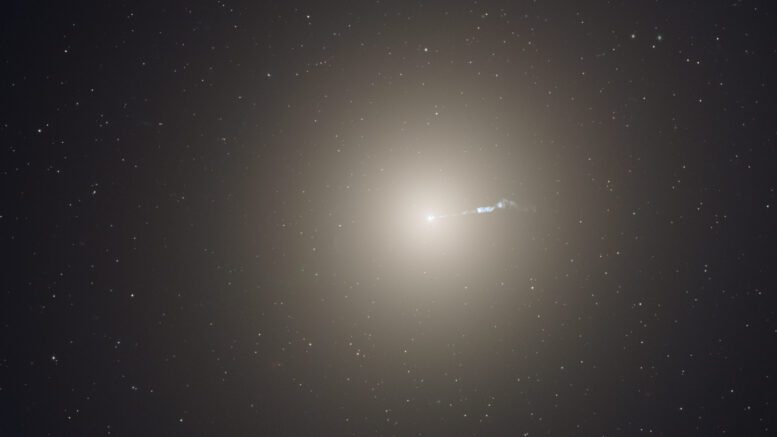Messier 87 is a supergiant elliptical galaxy with about 1 trillion stars in the constellation Virgo. The elliptical galaxy Messier 87 is the home of several trillion stars, a supermassive black hole and a family of roughly 15,000 globular star clusters. For comparison, our Milky Way galaxy contains only a few hundred billion stars and about 150 globular clusters.
| Description | |
| Visible From Pacific Northwest | January To May |
| Best Time To Observe | May |
| Minimum Size Of Viewing Device | Small Telescope |
| Object Type | Elliptical Galaxy |
| Designations | Messier 87, M87, NGC 4486, Virgo A, Smoking Gun, Virgo X-1, PGC 41361, UGC 7654, Arp 152, VCC 1316, 3C 274, 3U 1228+12, 1A 1228+12, GIN 800, H 1227+12, CTA 54, DA 325, DB 85, 2E 2744, 2E 1228.2+1240, GALEX J123049.4+122328, IRAS 12282+1240, 2MASX J12304942+1223279, MCG+02-32-105, MRC 1228+126, NRAO 401, NRL 8, PKS 1228+12, VPC 771 |
| Right Ascension | 12h 30m 49.42338s |
| Declination | +12°23’28.0439” |
| Constellation | Virgo |
| Number Of Stars | 1 trillion |
| Apparent magnitude | +9.59 |
| Absolute magnitude | -22 |
| Apparent dimensions | 7′.2 x 6′.8 |
| Object Radius | 60,000 light years |
| Distance From Earth | 53.5 million light years |
History
Virgo A was discovered by Charles Messier on March 18, 1781, along with seven other members of the Virgo Cluster – M84, M85, M86, M88, M89, M90 and M91 – and the globular cluster M92, located in the constellation Hercules.
John Herschel catalogued M87 as h 1301 and later added it to the General Catalogue as GC 3035. He described the object as “very bright; very large; round; much brighter toward the middle.”
Edwin Hubble categorized M87 as an elliptical extra-galactic nebula with no apparent elongation in 1926. At the time, M87 was the only elliptical nebula with resolvable stars. By 1931, Hubble identified it as a member of the Virgo Cluster. M87 was not identified as an E0-type galaxy until 1956. The classification was later modified to E0p, with the ‘p’ suffix indicating a peculiar galaxy, referring to its jet.
In June 2015, observations with the FLAMES spectrograph on ESO’s Very Large Telescope revealed that M87 has absorbed an entire medium-sized galaxy in the last billion years. Astronomers tracked the motions of 300 planetary nebulae and found evidence of both the merger and of excess light coming from the remains of the smaller galaxy.
Locating M87 In The Sky
Messier 87 is positioned near the border with the constellation Coma Berenices and can be found just over halfway along the line from the bright star Denebola in Leo to Vindemiatrix in Virgo. Another elliptical galaxy, Messier 89, lies just over a degree to the east, while Messier 84 and Messier 86 are about 1.5 degrees to the northwest of M87. Virgo A can also be located using the M84/M86 pair, positioned almost exactly halfway between Denebola and Vindemiatrix. Two fainter ellipticals, NGC 4476 and NGC 4378, can be seen in the same low power field of view as M87. Other galaxies in the vicinity include NGC 4478, NGC 4486A and NGC 4486B.

Viewing M87
The best time of year to observe M87 and other galaxies in the Virgo Cluster is during the spring. M87 can be observed in small and medium-sized telescopes.
In 10×50 binoculars, M87 appears only as a faint patch of light. Small telescopes show a fuzzy ball of light, elliptical in shape, with a slightly brighter centre. Being an elliptical galaxy, Virgo A appears mostly featureless even when seen in larger telescopes.
Photographing M87
Markarian’s Chain is a fantastic target for almost any type of instrument and camera. It is large enough to be photographed with small to medium size telescopes, and you can even capture it with just a DSLR camera and a telephoto lens! Bringing out the detail can be a bit challenging, but it is worth it. The best way to get guidance is to look at the link below or use astobin or cloudynights for a similar setup.
https://www.galactic-hunter.com/post/markarians-chain
Sources And Further Reading
Descriptions of all of Messier Objects can be found here.
https://www.nasa.gov/feature/goddard/2017/messier-87
https://www.messier.seds.org/m/m087.html

Be the first to comment on "Messier 87"